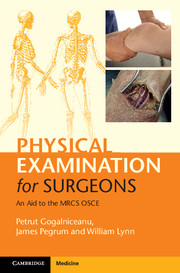Book contents
- Frontmatter
- Dedication
- Contents
- List of contributors
- Introduction
- Acknowledgments
- List of abbreviations
- Section 1 Principles of surgery
- Section 2 General surgery
- Section 3 Breast surgery
- Section 4 Pelvis and perineum
- Section 5 Orthopaedic surgery
- Section 6 Vascular surgery
- Section 7 Heart and thorax
- 30 Examination of the thorax and lungs
- 31 Examination of the heart and great vessels
- Section 8 Head and neck surgery
- Section 9 Neurosurgery
- Section 10 Plastic surgery
- Section 11 Surgical radiology
- Section 12 Airway, trauma and critical care
- Index
31 - Examination of the heart and great vessels
from Section 7 - Heart and thorax
Published online by Cambridge University Press: 05 July 2015
- Frontmatter
- Dedication
- Contents
- List of contributors
- Introduction
- Acknowledgments
- List of abbreviations
- Section 1 Principles of surgery
- Section 2 General surgery
- Section 3 Breast surgery
- Section 4 Pelvis and perineum
- Section 5 Orthopaedic surgery
- Section 6 Vascular surgery
- Section 7 Heart and thorax
- 30 Examination of the thorax and lungs
- 31 Examination of the heart and great vessels
- Section 8 Head and neck surgery
- Section 9 Neurosurgery
- Section 10 Plastic surgery
- Section 11 Surgical radiology
- Section 12 Airway, trauma and critical care
- Index
Summary
Checklist
WIPER
• Patient sitting on edge of examination couch with all clothing above the waist removed
Physiological parameters
General
• Bedside: GTN spray, cigarettes, oxygen
• Cachexia: severe mitral valve disease
• Morbidly obese: cor pulmonale
Inspection
• Hands: nicotine stains, radial artery harvest
• Neck: JVP
• Chest wall : scars of previous chest surgery (midline, lateral and posterior)
• Legs: groin incisions, varicose veins, scars from vein harvest
Palpation
• Hands: radial artery pulse: rate and rhythm
• Neck: carotid pulse, pulsatile trachea (aortic arch aneurysm), carotid–carotid or carotid–subclavian bypass, visible JVP
• Chest wall: apex beat, heaves, thrills, pacemaker, implantable defibrillator
• Sacrum: sacral oedema
• Legs : peripheral oedema, radio-femoral delay
Auscultation
• Carotid artery: bruit
• Precordium: heart sounds, murmurs, pericardial rub
• Lung bases: effusion, pulmonary oedema
To complete the examination…
• Chest x-ray
• ECG
Examination notes
What are the basic cardiac symptoms?
The main symptoms of cardiac disease are chest pain, shortness of breath, ankle swelling, orthopnoea, paroxysmal nocturnal dyspnoea, palpitations and syncope.
How do you prepare for the examination of the cardiac surgery patient?
The patient needs to be lying at 45° in underwear on the examination couch. The groins are covered but the legs are exposed.
What do you inspect in the examination of the heart?
• Jugular venous pressure (JVP). The patient is positioned at 45° with the head slightly turned to the contralateral side. Look for the JVP wave form and the height above the sternal notch. It should normally be seen 3 cm vertically above the sternal angle. A raised JVP is associated with congestive cardiac failure, pericardial tamponade or constrictive pericarditis. A collapsed JVP is caused by dehydration or shock.
• Identify scars from previous carotid endarterectomy.
• Inspect the chest for scars from previous cardiac or thoracic surgery.
• Inspect the legs for scars from previous saphenous vein harvest or varicose vein avulsions.
• The groins must be checked for evidence of previous vascular or endovascular surgery or percutaneous intervention.
• At the beginning or end of the examination the patient should be asked to stand, to look for varicose veins.
- Type
- Chapter
- Information
- Physical Examination for SurgeonsAn Aid to the MRCS OSCE, pp. 264 - 270Publisher: Cambridge University PressPrint publication year: 2015

